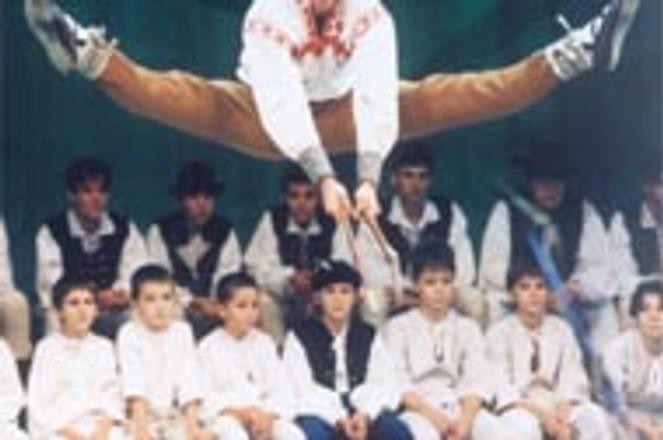High flier. Dancers in Lučnica, Slovakia's oldest folk group, are known for their athletic leaps as well as colorful musical routines and showmanship. Don't miss them as they celebrate 50 years with five performances in the next month. See story on page 17.Peter Brenkus
People often say "the older the wine the better it tastes," and this old saying was never more true than in the case of the world famous Slovak folklore group, Lúčnica. With its 50 year tradition, Lúčnica does more than just cheer you up.
In its most recent performance series, called "50 years of beauty," the folk group dazzles the audience for just under three hours of jam-packed music and dancing. The performance starts with a traditional dance from the upper Hron River valley in central Slovakia, with the thunder of boots heavily thumping the stage wood, and never looks back. The dancers exude joy and energy through their songs and dances.
Then, men come leaping across the stage, a take on tradional dances from Terchova, the birth place of Janošik, a Robin Hood-like Slovak folk hero. The performance perfectly balances athletic dancing with sweet folk melodies and violent instrumental solos.
Just after the audience has been lulled by the deep voices of Lúčnica singers from 50 years ago, the orchestra strikes up a heart-pounding jig. The violin and harpsicord players, eyes popping out of their heads, trade wicked arpeggios back and forth.
The climax of the night is a joyous toast to the success of the grape harvest. You don't have to be Slovak to appreciate the art of Lúčnica.
During the Czechoslovak era, Lúčnica was known as a top folklore group, a reputation the group has kept since the creation of Slovakia five years ago. Young dancers and great musicians are still the mainstay of the troupe's programs. "Lúčnica has not so much changed, it has just crystallized," said art director and choreographer Štefan Nosal. "Lúčnica is fifty years old now, and remains focused on folklore, from songs to oratorio."
The magic of Lúčnica, Nosal continued, " lies first of all in the hearts of Lúčnica's artistic creators. The group's continuity starts there, and is carried along by a tide of new blood." Nosal explained that anyone who is 16 or over can apply to join the group at Lúčnica's annual talent contest. Lúčnica dancers are generally from 16-23 years of age.
Mikulaš Civy, assistant to Lúčnica's choreographer and dance instructor, said that what really separates Lúčnica from other folklore groups in Slovakia is "Lúčnica's foundation of great dance routines, and its rich program which is technically well supported. Everything stands also on the cooperation between famous Slovak composers like Svetozar Stracina Nosal himself."
With Štefan Nosál, troupe members agree, Lúčnica rocks. "Nosal is a man who just grabs a hold of people's imaginations," said Civy.
Lúčnica's latest show, entitled "50 years of beauty," features 21 dancing pairs, a 15-member orchestra and a 12-strong choir.
According to Nosal, the new show includes various elements that give the audience an idea of the group's fifty-year history. "The show consists of a mixture of retrospective and new dance elements from Slovakia's regions. We went through our memories of the past fifty years, but it was difficult choose which of the 80 different dance routines should be restaged."
Helping Nosal make it all possible were the Ministry of Culture, Slovnaft and Tabak s.r.o., whose money must be considered well spent.
Author: Ludmila Herdova

